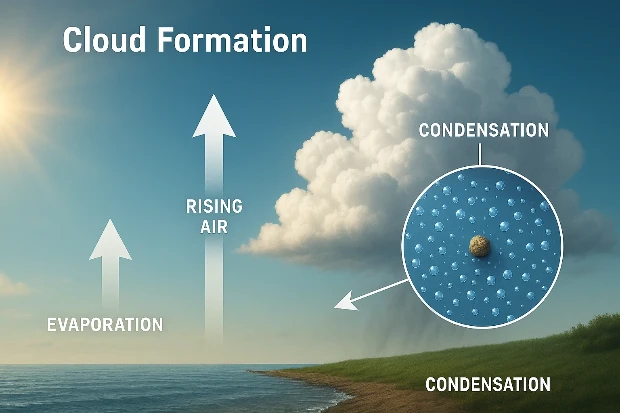Is a Cloud Gas or Liquid?
Answer:
A cloud is made of tiny liquid water droplets and sometimes ice crystals, not gas. Even though clouds float in the sky like mist, they’re actually made of condensed water that formed when water vapor (a gas) cooled down. So, clouds are mostly liquid, even though they start from water in gas form.
Dive Deeper
- What Are Clouds Made Of?
- From Gas to Liquid: How Clouds Form
- Why Do Clouds Float?
- Are There Any Clouds Made of Ice?
- 🎯 Final Thoughts
- 📚 References
What Are Clouds Made Of?
Clouds may look like puffy white gas, but they’re actually filled with millions of tiny water droplets. Each droplet is about 10 micrometers in diameter—that’s about 1/10 the width of a human hair.
| Cloud Material | State of Matter |
|---|---|
| Water droplets | Liquid |
| Ice crystals (in cold clouds) | Solid |
| Water vapor (before cloud forms) | Gas |
💧 So once a cloud forms, it’s not gas anymore—it’s mostly liquid or solid.
From Gas to Liquid: How Clouds Form
Clouds begin with water vapor, which is a gas. But clouds themselves are not made of vapor—they’re made of condensed water.
Here’s how the process works:
- Evaporation: Sunlight heats lakes, oceans, or puddles. Water evaporates into water vapor (gas).
- Rising Air: The warm air carrying water vapor rises into the atmosphere.
- Cooling: As the air rises, it cools. Cooler air can’t hold as much vapor.
- Condensation: Water vapor turns back into tiny liquid droplets and clings to condensation nuclei.
- Cloud Formation: These droplets gather together and become visible as a cloud.
🧪 Condensation nuclei are tiny particles in the air, like dust, salt, ash, or even pollution. Water vapor needs these particles to condense on—without them, clouds wouldn’t form.
🌡️ According to the National Weather Service, condensation usually starts when air cools to its dew point, often between 32°F and 68°F (0°C to 20°C) [1].
Why Do Clouds Float?
You might wonder—if clouds are made of liquid water, why don’t they fall?
The answer: each droplet is incredibly small and light, and the air beneath the cloud is rising. This upward movement helps keep the droplets suspended.
Also:
- The droplets are spread out—not clumped like raindrops.
- As long as the updraft (rising air) is stronger than the pull of gravity on the droplets, the cloud stays up.
Eventually, when the droplets combine into larger drops and get too heavy, gravity wins—and it rains.
Are There Any Clouds Made of Ice?
Yes! Some clouds are found very high in the sky, where temperatures are below freezing. These clouds are made of tiny ice crystals instead of water droplets.
| Type of Cloud | Altitude | Made Of |
|---|---|---|
| Cumulus | Low (~2,000 m) | Water droplets |
| Stratus | Low to mid-level | Water droplets |
| Cirrus | High (~6,000+ m) | Ice crystals |
| Cumulonimbus | Very tall (up to 16,000 m) | Water + ice |
🌬️ Cirrus clouds, which look wispy or feathery, are a good example of clouds made from ice. They’re often seen on clear days and signal a change in the weather.
🎯 Final Thoughts
So, is a cloud gas or liquid? The answer is: mostly liquid, and sometimes solid if it’s high up. While clouds begin with water vapor (a gas), they become visible only after that vapor condenses onto condensation nuclei into tiny water droplets or ice crystals. These droplets are so small and light that they can float in the air, forming the beautiful clouds we see in the sky.
Clouds are one of nature’s most fascinating mixtures of science and beauty—proof that even tiny droplets can make a big impact.
📚 References
- National Weather Service. “How Do Clouds Form?”
https://www.weather.gov/jetstream/cloud - NOAA SciJinks. “What Are Clouds Made Of?”
https://scijinks.gov/clouds/ - NASA Earth Observatory. “Clouds.”
https://earthobservatory.nasa.gov/features/Clouds - UCAR Center for Science Education. “Cloud Formation.”
https://scied.ucar.edu/learning-zone/clouds/cloud-formation - Britannica. “Cloud | Meteorology.”
https://www.britannica.com/science/cloud-meteorology
📌Learn More About Clouds
- What Are Clouds Made Of?🌥️Tiny Drops with Big Jobs in the Sky
- How Do Clouds Form?🌥️The Science Behind Sky Blankets
- What Are the Names of All the Cloud Types?🌥️A Guide to Sky Shapes and Weather Clues
- What Is Fog and Is It a Cloud?🌥️The Cloud That Touches the Ground
- What Clouds Produce Rain?🌥️The Sky’s Water Factories Explained

